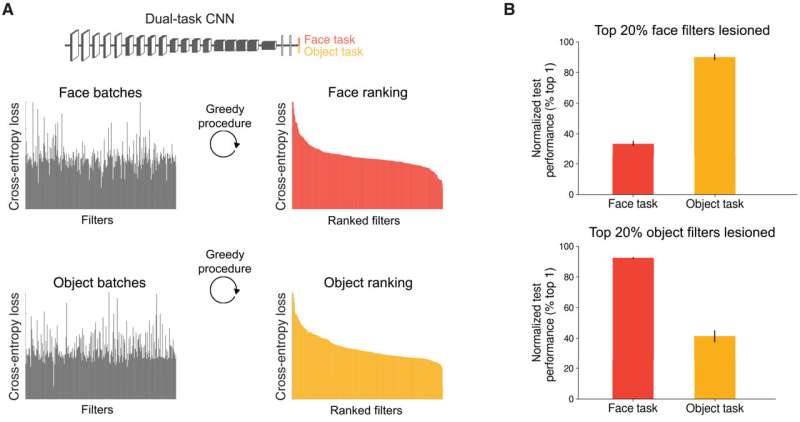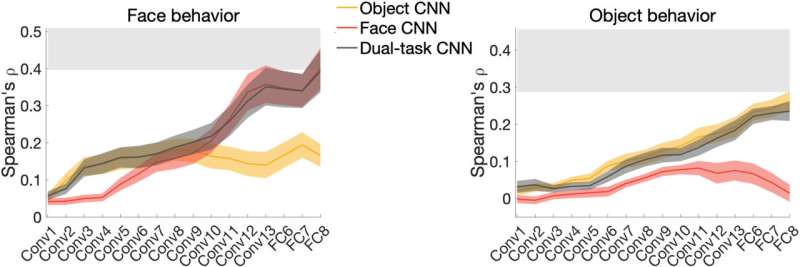Distinct face and object representations in singly trained CNNs while a dual-task CNN performs well. (A) Three networks with VGG16 architecture (left) were optimized, one on face identity categorization (Face CNN in red), one on object categorization (Object CNN in orange), and one on both tasks simultaneously (dual-task CNN in gray). (B) Decoding accuracy of held-out face identities and held-out object categories using activation patterns extracted from the penultimate layer [i.e., FC2 in (A)] of the Face CNN and the Object CNN. The Face CNN outperforms the Object CNN in face decoding and vice versa for object decoding. Thus, the representations optimized for each task do not naturally support the other. The dashed gray line indicates chance level (1%). Error bars indicate SEM across classification folds. (C) A dual-task CNN optimized on both tasks performed and the separate networks (% top 1 accuracy on the test set). Error bars denote 95% confidence interval (CI) bootstrapped across classes and stimuli. Credit: Science Advances (2022). DOI: 10.1126/sciadv.abl8913
The human brain has distinct and highly specialized functional regions to understand languages, recognize faces and plan ahead. However, neuroscientists must still decipher the high degree of functional specialization observed in the cortex. In a new study now published in Science Advances, Katharina Dobs and a team of scientists at the department of brain and cognitive sciences, MIT and the Zuckerman Mind Brain and Behavior Institute, Columbia University, New York, U.S., investigated face perception with artificial neural networks to test the hypothesis that functional segregation of facial recognition in the brain reflected computational optimization for broader applications of visual facial recognition. The team showed how functional visual segregation revealed a widespread tendency for optimization to create functional specialization in machines, and also further investigate the complexity of the phenomenon relative to brains.
Functional specialization
While the idea of functional localization in the brain was met with controversy for centuries, it is now supported with overwhelming evidence. Regions of the cortex can be selectively activated for a specific perceptual or cognitive task, which when disrupted can produce selective impairment. Neuroscientists increasingly aim to understand why the brain exhibits this level of functional specialization. Possibilities include an accident of evolution to easily add modules and solve new problems. Researchers have also highlighted selective modulation of mental processes via functional specialization. And a third possibility is the computational reasons to complete tasks that cannot be solved with comparatively generic machinery. In this work, Dobs et al. tested the third hypothesis to understand one of the best-established cases of functional specialization in the brain relative to visual recognition of faces. The team employed advanced deep convolutional neural networks (CNNs) to achieve human-level performance on some visual recognition tasks. Based on extensive studies with object-trained and face-trained networks on face and object recognition, Dobs et al. revealed a general tendency for task segregation in networks, opening the door to investigate specific architectures, and training diets to detect the tasks that will be segregated in networks, and hypothetically also in brains.
Lesion experiments in the last convolutional layer reveal spontaneous task segregation. (A) Schematic of lesion experiments for the last convolutional layer (see “Conv13” in Fig. 1A) in VGG16. Each filter in the layer was ablated while measuring the loss to batches of face (top) and object (bottom) images. The filters were rank-ordered by their corresponding losses to determine those that contribute most to face (red) or object recognition (orange). (B) Normalized performance of face and object tasks after lesioning the 20% highest-ranking filters for the face task (top) and the object task (bottom) in the last convolutional layer. Error bars denote 95% CIs bootstrapped across classes and stimuli. Credit: Science Advances (2022). DOI: 10.1126/sciadv.abl8913
Networks trained only on objects do not perform well on face recognition
To test if the object-trained CNNs serve face recognition and vice-versa, Dobs et al. trained two randomly initialized VGG16 networks, as proposed initially by A. Zisserman and K. Simoyan from the University of Oxford, for face identification and object categorization. The team decoded unfamiliar face identities from face-trained networks and unfamiliar objects from the object-trained network, as expected. They noted significantly worse performance at face-recognition with the object-trained network than the face-trained network, and vice-versa for object recognition, indicating how representations learned for a specific-task did not readily translate to another task. Much like the brain, each task appeared to benefit from specialized task-specific representations.
Spontaneous segregation of face and object tasks in mid-level processing stages. (A) Task segregation, measured as combined index of the differences in proportional drops in performance on the face and object task, when the 20% highest-contributing filters are dropped in each convolutional layer. Task segregation increased after the first convolutional layers to a maximum index of 0.75. Shaded area represents 95% CIs bootstrapped across classes and stimuli. (B) Images optimized to drive responses in three example filters among the top 10 selected filters for the face (left) and the object (right) task in convolutional layers 5, 9, and 13 (rows). The size of the receptive fields increases, and features become more task specific in later layers. Credit: Science Advances (2022). DOI: 10.1126/sciadv.abl8913
Forming a dual-trained network
To circumvent limitations, Dobs et al. questioned if training a single network to perform both tasks would lead to discovering a common high-performing feature space for faces and objects. To address this, they trained a new network on both face identity and object categorization. The dual-task network unexpectedly performed nearly as well on each task, indicating a common feature space for the networks to solve both tasks, arguing against the hypothesis of functional specialization for high task performance. Another possibility was that the network learned to segregate itself into face and object recognition, although the team did not build anything into the network architecture to facilitate this. To test this possibility, they performed a series of experiments, and the results indicated spontaneous segregation of the network into distinct subsystems for face and object recognition, despite the lack of a task-specific, inductive bias to encourage the outcome.
Dual-trained CNN is most correlated with behavior. Correlations between behavioral RDMs for either face (left, n = 14) or object (right, n = 15) stimuli and layer-specific RDMs obtained from activation patterns in the Face CNN (red), the Object CNN (in yellow), and the dual-task CNN (in gray) to the corresponding stimuli. Color-shaded areas denote bootstrapped SEM across participants. Gray-shaded horizontal bars indicate estimated noise ceiling based on the variability across participants. Credit: Science Advances (2022). DOI: 10.1126/sciadv.abl8913
Increased task segregation across layers like the brain
Dobs et al. next determined if task segregation built up on layers of the network. In primate brains, the usual categories are processed to share an initial set of common features, during early stages of processing (retina etc.), followed by branching into category-specific pathways (face, body, etc.). The team sought to understand such similarities with the dual-trained CNNs (convolutional neural networks) and found task segregation to be small in early layers, while increasing with later layers. According to the outcomes, processing of faces and objects gradually diverged at middle stages of processing within the network to become highly segregated in latter stages, much like those features observed in the primate brain. Further studies of the features highlighted the processing hierarchy. The outcomes showed that the observed high degree of functional segregation did not arise from dataset biases but were driven by distinct mid-to-high level visual features per task.
Spontaneous segregation to varying degrees for food or car recognition. (A) In addition to the dual-task model for face and object tasks (red), we trained one dual-task model on food (green) and object categorization and another one on car (blue) and object categorization. (B) Task segregation was measured by lesioning the most-contributing filters for faces, food, and cars (respectively) and objects in each convolutional layer. Task segregation was found for all tasks to varying degrees. Task segregation for cars and objects increased later, to a lesser degree, than for food or faces and objects. Color-shaded areas denote 95% CIs bootstrapped across classes and stimuli. Credit: Science Advances (2022). DOI: 10.1126/sciadv.abl8913
Functionally segregated networks and varying functional segregation
The work mirrored functional specialization in the human visual system, although it was unclear if the learned feature species could perform as similarly to the human visual system. To examine this, Dobs et al. ran two behavioral experiments to measure the perceived similarity of face and object stimuli. For each task, the team correlated the behavioral representation dissimilarity matrices of each participant for each layer of face-trained, object-trained and dual-task trained convoluted neural networks. The dual-task network captured human behavior in both face and tasks to show how learned solutions performed tasks similar to the human visual system and explored this setup for other visual categories. The outcome indicated that while functional segregation found in the brain could also be found in convoluted neural networks, brains did not entirely resemble the nuances of neural networks.
Outlook
In this way, Katharina Dobs and colleagues comprehensively examined functional specialization of brain organization to test the hypothesis that specialization in the brain may result from optimization for multiple natural tasks. They predicted that vastly different computational systems may arrive at a similar solution and tested the hypothesis in convoluted neural networks (CNNs) to understand one of the best-established cases of functional specialization in the brain—face recognition. The outcomes interestingly highlighted why the brain is organized the way it is. The results indicate functional segregation to be a natural consequence of solving multiple tasks. The methods developed in this work will enable the scientists to test these hypotheses and further ideas.
More information: Katharina Dobs, Julio Martinez Alexander, J. E. Kell and Nancy Kanwisher, Brain-like functional specialization emerges spontaneously in deep neural networks, Science Advances (2022). DOI: 10.1126/sciadv.abl8913
Guangyu Robert Yang et al, Task representations in neural networks trained to perform many cognitive tasks, Nature Neuroscience (2019). DOI: 10.1038/s41593-018-0310-2
Journal information: Science Advances , Nature Neuroscience
© 2022 Science X Network
![Distinct face and object representations in singly trained CNNs while a dual-task CNN performs well. (A) Three networks with VGG16 architecture (left) were optimized, one on face identity categorization (Face CNN in red), one on object categorization (Object CNN in orange), and one on both tasks simultaneously (dual-task CNN in gray). (B) Decoding accuracy of held-out face identities and held-out object categories using activation patterns extracted from the penultimate layer [i.e., FC2 in (A)] of the Face CNN and the Object CNN. The Face CNN outperforms the Object CNN in face decoding and vice versa for object decoding. Thus, the representations optimized for each task do not naturally support the other. The dashed gray line indicates chance level (1%). Error bars indicate SEM across classification folds. (C) A dual-task CNN optimized on both tasks performed and the separate networks (% top 1 accuracy on the test set). Error bars denote 95% confidence interval (CI) bootstrapped across classes and stimuli. Credit: Science Advances (2022). DOI: 10.1126/sciadv.abl8913 The spontaneous emergence of brain-like functional specialization in neural networks](https://scx1.b-cdn.net/csz/news/800a/2022/the-spontaneous-emerge.jpg)



























